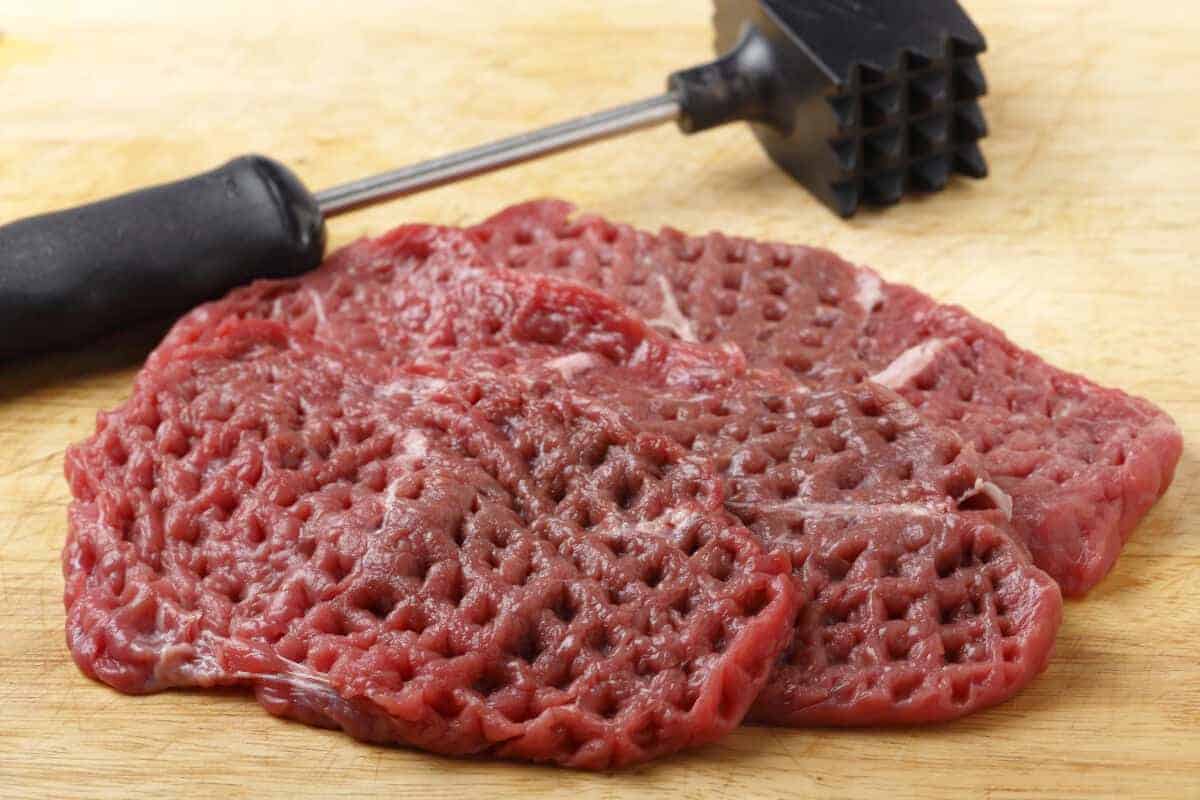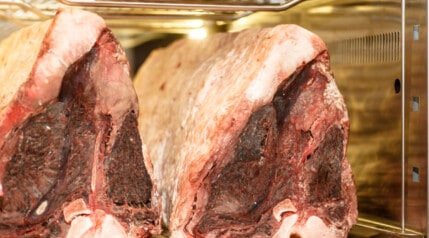
In this article, we’ll explain how to tenderize steak, what tenderizing actually is, what it means, and walk you through a handful of different processes.
You want to save money, right?
At some point in each of our lives, we’ve all tried to make more out of something than perhaps it had a right to be to save some cash. Making a silk purse out of the sow’s ear, as it were. (With the popularity of nose-to-tail butchering, you might prefer to make a meal out of the ears.)
It’s no different with meat. You might have your heart set on a perfectly marbled Top Sirloin, or a Porterhouse the size of your face. So what can you do if your wallet has something more modest in mind?
With just a little effort, you can get a great meal out of a budget-friendly steak.
By the end of this article, you’ll be able to tenderize a low-cost steak to improve flavor and mouth-feel, elevating it to almost high-end cut status.
Jump to:
What is Tenderizing?
Tenderizing is any process that breaks up the connective tissue in a cut of meat, to make it feel more tender, or ‘taking away the feeling of chewy toughness.’
This can be a physical process or a chemical one.
Why Should I Tenderize My Steak?

Not all steaks are created equal. While there are some very tender steak cuts, notably strip loins and tenderloins, others may be tough.
A muscle that gets a regular workout will be tougher than one that has little to do. That’s why shank and brisket need to be cooked for so long, they do so much ‘work’ in the animal, they are incredibly strong and hence tough muscles.
Sometimes, though, even a traditionally tender cut might be tough just because the cow really wasn’t the star of the herd to start with.
Since not all of us can afford the best steaks every time, it’s good to know you can tenderize a low-cost steak to make it more enjoyable. In fact, I think budget steaks present a great chance to experiment with rubs, marinades, and sauces without worrying so much about ruining an expensive piece of meat.
You can sometimes get great deals on buying an entire side of beef. If you knew you could make a great meal out of even the cheapest cuts, wouldn’t that make it worth the investment?
How to Tenderize Steak — 6 Ways, Something for Everyone
There are several different approaches you can take for tenderizing your steak. Some require advance planning, while others can be done spur of the moment.
Let’s take a look:
1. Wet Brining

Wet brining involves soaking your steak in a saltwater bath for an extended period. The salt penetrates the tissue and relaxes proteins. Relaxing the proteins makes the meat a lot less chewy. As an added bonus, the water keeps the meat moist.
Wet brining a steak does carry the risk of diluting the flavor, so you’ll want to watch your timing.
If you want to learn more about wet brining, you’re in luck! We’ve got an article devoted to it right here: Detailed guide to wet brining.
2. Marinating

Marinating is a bit like brining in that the idea is to immerse your steak in liquid. This is a simple but effective way to add flavor. But will it tenderize your steak?
The answer to that depends on what your marinade is made of. Unless there is an acidic component to the marinade, nothing’s going to change. A vinegar or fruit juice-based marinade will go to work on the connective tissues.
Your best bets for fruit marinades are pineapple juice or papaya juice. They contain enzymes commonly used for meat tenderizing. It’s important to use fresh or frozen juice, and not canned — unfortunately, the heat used in the pasteurizing process destroys the enzymes, rendering them useless for tenderizing.
3. Braising

Another fluid-based method, braising is the act of simmering meat in a fluid, usually for an extended period of time. You can do this on the stovetop, or on the grill, with a deep pan.
The heat breaks down the connective tissue, melting it into the flesh. Because the heat is low, the meat doesn’t just cook and dry out, and of course, the fluid keeps it moist.
Braising offers another chance to get creative with flavor — you can braise in nearly any fluid or combination thereof, including wine, beer, apple or tomato juice, Worcestershire sauce, add in extra herbs and spices, and so on.
4. Meat Tenderizing Powder

Many companies offer a ready-mixed tenderizer you rub into your steak. Most blends include salt and either bromelain or papain, the enzymes found in pineapple and also in papaya, respectively.
As explained earlier, these enzymes go to work on proteins (they must not like them, for some reason), breaking them down and making your steak less chewy. You can buy tenderizer with or without additional seasoning.
To use a tenderizing powder, all you have to do is moisten the meat to aid adhesion, sprinkle on the tenderizing powder, pierce the steak a few times with a fork, and you’re ready. It’s simple and reasonably effective.
5. Pounding

The most straightforward and most satisfying way to tenderize a steak is to beat the hell out of it. You can buy a meat hammer just for this purpose, but any solid, heavy object will do. Just make sure that your tenderizing implement, and your work surface, are both up to the job. For example, I wouldn’t recommend anything glass for either.
Wrap the meat in plastic, or zip it up in a resealable bag. This helps keep the juices in and lessens the likelihood of contaminating your work area or whacking device.
The repeated blows will break the connective tissue, making the meat less tough and chewy. There is also the added bonus that your now flat steak is thinner and will need less time on the grill to cook. Shorter time on the grill means less chance to toughen up again.
If you’re thinking of buying a meat hammer, look for a nice solid one, preferably one without a wooden handle. (Wood is hard to clean and keep contaminant-free.)
You’ll notice the hammer has a flat face and a bumpy face. The bumpy side is for tenderizing, and the flat side is for flattening already tender cuts into thinner tender cuts.
6. Poking

A similar method as pounding, but instead you’re actually stabbing the steak over and over.
Commercially available devices with rows of small spikes at the end of a handle make the job quick and easy. These are both great ways to get your aggressions out.
Our Preferred Method For Tenderizing Steak? Salting or Dry Brining
All the above methods will work, but dry brining is our favorite. It’s quick and simple to do, and the results are always excellent. Want to know more? You’ve got it.
How Salting / Dry Brining Steak Works
Dry brining is the act of rubbing salt into your steak. Salt is a natural flavor enhancer, but it’s also great for tenderizing.
Salt penetrates the surface of the meat, and, among other things, breaks down the proteins that make steak chewy. While you’re at it, you can add other stuff for flavor, too, if you like.
Hop over to our complete coverage of the topic right here for a thorough examination of dry brining,
What Salt Should I Use for Dry Brining Steak?

There are many types of salt. To brine effectively, you want to use one that is coarse grained. For that reason, table salt is not preferred for brining; it’s meant for running freely out of a shaker and enhancing flavor without adding grit.
For a good dry brine, use Kosher Salt, or Sea Salt. Each of these has the large grains you need to do the job. You could possibly use Canning, or Pickling Salt, but this might not be the best choice. It’s very dense, so it’s easy-to-use too much.
You should also avoid Curing Salt. This is a specialty salt that contains sodium nitrate and/or sodium nitrite. Curing Salt is only for meat preservation and preparing for cold smoking.
You can click here to learn a lot more about the different types of salt, their uses, and more.
Step-By-Step Guide to Dry Brining Steak

Me, I like things broken down into easy-to-follow steps. So, assuming you’re like me, here is how to dry brine your budget steak to make a gourmet meal!
- Buy your steak — chuck steaks, skirt steaks, or just plain cheap steaks. Anything that’s a bargain.
- Measure out about ½ teaspoon of salt for each pound of meat.
- Sprinkle the salt evenly over both sides of the steak. Add more if necessary to achieve full coverage.
- Let the steak rest, uncovered, on a plate on your counter. (Step 4b might be to lock up your dog.)
- Leave the steak for about 1 hour per inch up to a maximum of 2 hours.
- Rinse the steak thoroughly, and then pat dry with paper towel. (Unless you want a salt lick instead of a steak.)
- Grill it. Eat it. Love it.
Remember to keep your hands clean — wash them after every time you handle the raw steak, and the plates or platters you use. Also, be careful not to drip on your counter, and clean up ASAP if you do.
Love Me Tender — Steak!
Here’s the best news you’ll read today: great barbecue doesn’t have to break the bank!
If you’re a steak connoisseur, don’t feel the need to turn your nose up at a budget steak. And if you love steak, but can’t afford Prime cuts every weekend, we hope this article will help you get more enjoyment out of your grill.
If you haven’t already run off to the store to grab some steaks, we invite you to share your new learning with your friends, family, co-workers, and social media followers. Together, we can put an end to crappy steaks forever.
If something in this article didn’t sit right with you, or if you have anything you’d like to add to the conversation, speak up in the comments section below! We love hearing from our readers on any topic.
There are lots more articles to explore on the site, so come join the journey of barbecue discovery with us! If you need to take off for now, thanks sincerely for spending some time with us.
Catch you grill-side!






Thanks
Great can’t wait to have dinner tonight
Very helpful and to the point!
Thanks!!
Thank you for your information. Going to use it to cook my steak dinner 👌
Thanks so much!
I absolutely love your humorous wording of simple directions!
Gotta go now and try them out.
Thanks, Carole!
To tenderize your steak marinate it in the refrigerator overnight with sliced kiwi instead of pineapple. Kiwi is flavorless but pineapple will make the steak flavor like the taste of pineapple. Use Kiwi to marinate you steak like outstanding chefs at upscale restaurants.
My dad liked round steak and tenderized it with tenderizing salt and pounded it with a tenderizing hammer.
I stumbled onto this and it made the best, most tender filet ever. I do it every time now.
Add the amount of salt I would have used for a dry brine into buttermilk. I throw the steak into a freezer bag and pour in the salted buttermilk. Squeeze all of the air out and seal it up. I massage the bag a bit to make sure the brine is evenly distributed. I leave it 4-24 hours and flip it over occasionally.
I do all of my meats this way now. I own thanksgiving day turkey for my family!
I sometimes marinate chicken in buttermilk and it’s crazy good! I’ve never though to try with a steak, I’ll give it a go. Thanks, Brad.
I just found this link and I want to say THANK YOU !!!! I have 5 Beef eye of round steaks and being a Federal Food Inspector I know that that cut of meat is very tough !!! I just rubbed down my steaks with kosher salt and then seasoned them with some Meat Church seasoning and placed then in a vacuum seal bowl and vacuum sealed the bowl. I will take them out tomorrow and finish the process. Thank you for all the great tips !!!
What is the best way to tenderize skirt steak
Thank you
Hi Marietta. Marinating is your best bet. With what is up to you, but an acidic or enzymatic marinade for sure.
I have seen several posts about tenderising. The method velvetising seems good but quite different s it add a large amount of water to the thinly sliced meat. Also using bi carbonate of soda.